Note
Go to the end to download the full example code.
RP75 analysis and 2D graphics¶
The objective of this example is to present problem 75 of the BBRC. We also present graphic elements for the visualization of the limit state surface in 2 dimensions.
This problem has two dimension and a reference probability approximately equal to $10^{-2}$. Hence, the problem should be relatively easy to solve. The failure domain is made of two separate sub-domains, leading to two different design points. Hence, the FORM approximation cannot be accurate, because it systematically ignores one of them, no matter what point is found by the optimization algorithm.
import openturns as ot
import openturns.viewer as otv
import otbenchmark as otb
problem = otb.ReliabilityProblem75()
print(problem)
name = RP75
event = class=ThresholdEventImplementation antecedent=class=CompositeRandomVector function=class=Function name=Unnamed implementation=class=FunctionImplementation name=Unnamed description=[x1,x2,y0] evaluationImplementation=class=SymbolicEvaluation name=Unnamed inputVariablesNames=[x1,x2] outputVariablesNames=[y0] formulas=[3 - x1 * x2] gradientImplementation=class=SymbolicGradient name=Unnamed evaluation=class=SymbolicEvaluation name=Unnamed inputVariablesNames=[x1,x2] outputVariablesNames=[y0] formulas=[3 - x1 * x2] hessianImplementation=class=SymbolicHessian name=Unnamed evaluation=class=SymbolicEvaluation name=Unnamed inputVariablesNames=[x1,x2] outputVariablesNames=[y0] formulas=[3 - x1 * x2] antecedent=class=UsualRandomVector distribution=class=JointDistribution name=JointDistribution dimension=2 copula=class=IndependentCopula name=IndependentCopula dimension=2 marginal[0]=class=Normal name=Normal dimension=1 mean=class=Point name=Unnamed dimension=1 values=[0] sigma=class=Point name=Unnamed dimension=1 values=[1] correlationMatrix=class=CorrelationMatrix dimension=1 implementation=class=MatrixImplementation name=Unnamed rows=1 columns=1 values=[1] marginal[1]=class=Normal name=Normal dimension=1 mean=class=Point name=Unnamed dimension=1 values=[0] sigma=class=Point name=Unnamed dimension=1 values=[1] correlationMatrix=class=CorrelationMatrix dimension=1 implementation=class=MatrixImplementation name=Unnamed rows=1 columns=1 values=[1] operator=class=Less name=Unnamed threshold=0
probability = 0.00981929872154689
event = problem.getEvent()
g = event.getFunction()
problem.getProbability()
0.00981929872154689
Create the Monte-Carlo algorithm
algoProb = ot.ProbabilitySimulationAlgorithm(event)
algoProb.setMaximumOuterSampling(1000)
algoProb.setMaximumCoefficientOfVariation(0.01)
algoProb.run()
Get the results
resultAlgo = algoProb.getResult()
neval = g.getEvaluationCallsNumber()
print("Number of function calls = %d" % (neval))
pf = resultAlgo.getProbabilityEstimate()
print("Failure Probability = %.4f" % (pf))
level = 0.95
c95 = resultAlgo.getConfidenceLength(level)
pmin = pf - 0.5 * c95
pmax = pf + 0.5 * c95
print("%.1f %% confidence interval :[%.4f,%.4f] " % (level * 100, pmin, pmax))
Number of function calls = 1000
Failure Probability = 0.0060
95.0 % confidence interval :[0.0012,0.0108]
Compute the bounds of the domain¶
inputVector = event.getAntecedent()
distribution = inputVector.getDistribution()
X1 = distribution.getMarginal(0)
X2 = distribution.getMarginal(1)
alphaMin = 0.00001
alphaMax = 1 - alphaMin
lowerBound = ot.Point(
[X1.computeQuantile(alphaMin)[0], X2.computeQuantile(alphaMin)[0]]
)
upperBound = ot.Point(
[X1.computeQuantile(alphaMax)[0], X2.computeQuantile(alphaMax)[0]]
)
nbPoints = [100, 100]
figure = g.draw(lowerBound, upperBound, nbPoints)
figure.setTitle("Iso-values of limit state function")
_ = otv.View(figure)
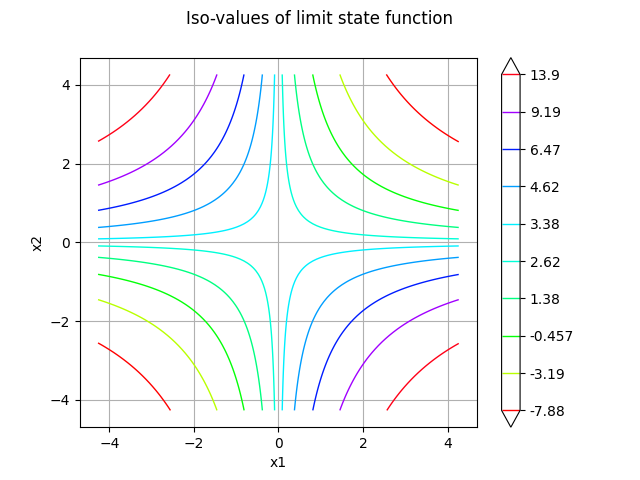
Print the iso-values of the distribution¶
_ = otv.View(distribution.drawPDF())
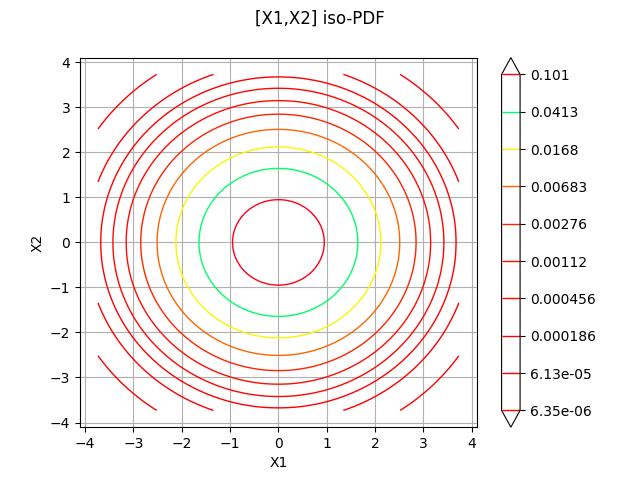
sampleSize = 5000
drawEvent = otb.DrawEvent(event)
cloud = drawEvent.drawSampleCrossCut(sampleSize)
_ = otv.View(cloud)

Draw the limit state surface¶
bounds = ot.Interval(lowerBound, upperBound)
bounds
graph = drawEvent.drawLimitStateCrossCut(bounds)
graph.add(cloud)
_ = otv.View(graph)
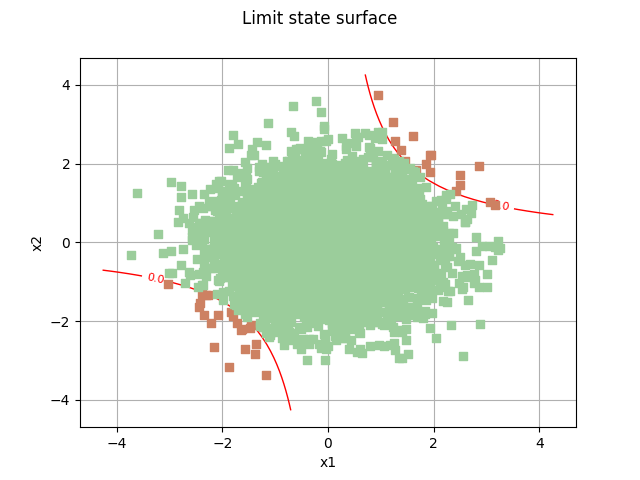
domain = drawEvent.fillEventCrossCut(bounds)
_ = otv.View(domain)
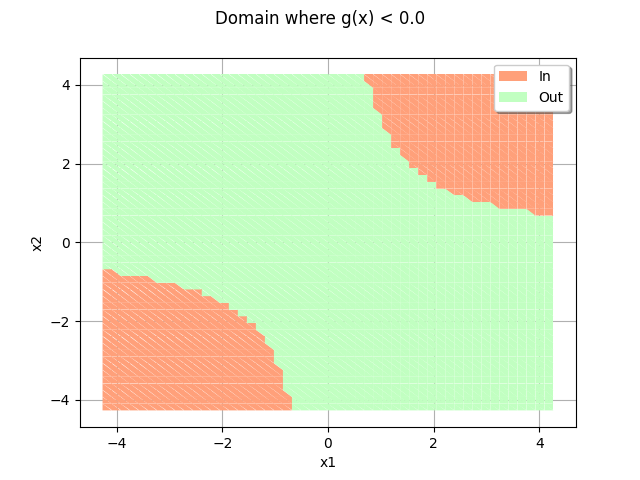
domain.add(cloud)
_ = otv.View(domain)
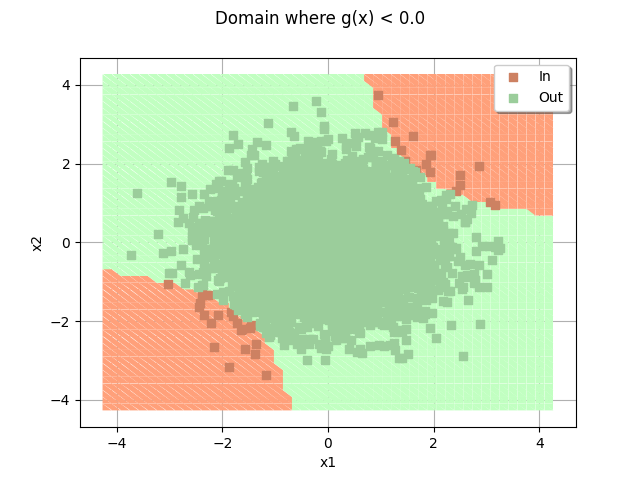
Test with FORM method¶
We create a NearestPoint algorithm
nearestPointAlgorithm = ot.Cobyla()
# Resolution options:
eps = 1e-3
nearestPointAlgorithm.setMaximumCallsNumber(1000)
nearestPointAlgorithm.setMaximumAbsoluteError(eps)
nearestPointAlgorithm.setMaximumRelativeError(eps)
nearestPointAlgorithm.setMaximumResidualError(eps)
nearestPointAlgorithm.setMaximumConstraintError(eps)
initialNumberOfCall = g.getEvaluationCallsNumber()
mean = distribution.getMean()
algoFORM = ot.FORM(nearestPointAlgorithm, event, mean)
algoFORM.run()
resultFORM = algoFORM.getResult()
numberOfFunctionEvaluationsFORM = g.getEvaluationCallsNumber() - initialNumberOfCall
probabilityFORM = resultFORM.getEventProbability()
print("Number of calls to the limit state =", numberOfFunctionEvaluationsFORM)
print("Pf =", probabilityFORM)
Number of calls to the limit state = 155
Pf = 0.007161044716104123
We create a NearestPoint algorithm
nearestPointAlgorithm = ot.AbdoRackwitz()
# Resolution options:
eps = 1e-3
nearestPointAlgorithm.setMaximumCallsNumber(100)
nearestPointAlgorithm.setMaximumAbsoluteError(eps)
nearestPointAlgorithm.setMaximumRelativeError(eps)
nearestPointAlgorithm.setMaximumResidualError(eps)
nearestPointAlgorithm.setMaximumConstraintError(eps)
If the mean point is used as a starting point with the AbdoRackwitz class, then the algorithm fails with: RuntimeError: InternalException : Error in Abdo Rackwitz algorithm: the gradient of the level function is zero In order to fix this, we just use a different starting point.
startingPoint = mean + [1.0e-3] * 2
initialNumberOfCall = g.getEvaluationCallsNumber()
mean = distribution.getMean()
algoFORM = ot.FORM(nearestPointAlgorithm, event, startingPoint)
algoFORM.run()
resultFORM = algoFORM.getResult()
numberOfFunctionEvaluationsFORM = g.getEvaluationCallsNumber() - initialNumberOfCall
probabilityFORM = resultFORM.getEventProbability()
print("Number of calls to the limit state =", numberOfFunctionEvaluationsFORM)
print("Pf =", probabilityFORM)
Number of calls to the limit state = 16
Pf = 0.007148267752544499
mean
g.gradient(mean)
otv.View.ShowAll()
Total running time of the script: (0 minutes 3.235 seconds)
 otbenchmark
otbenchmark